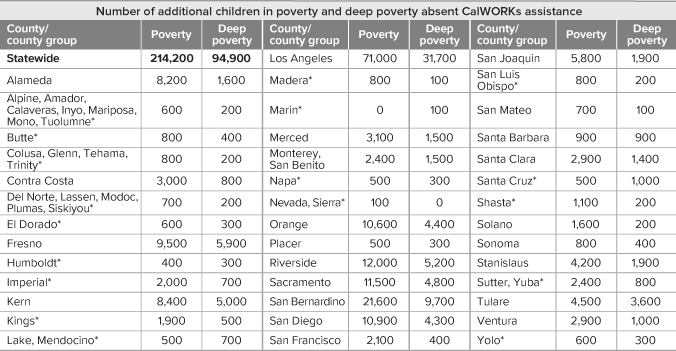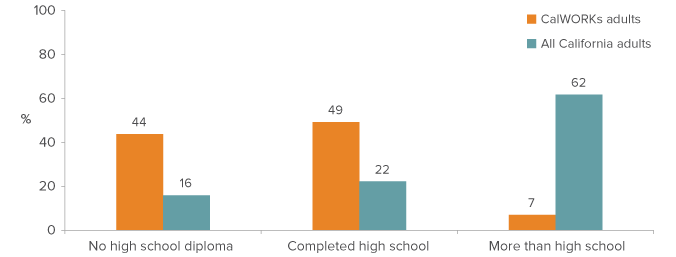- CalWORKs is a key component of California’s safety net for low-income families.
Established in 1998, the California Work Opportunity and Responsibility to Kids (CalWORKs) program provides cash assistance to very low-income families with few assets. Most eligible parents must make progress toward finding and keeping a job or face loss of their grant; children remain eligible regardless of their parents’ program status. As of 2017, the vast majority (81.4%) of CalWORKs recipients are children. CalWORKs is jointly funded by federal, state, and county governments. - The federal block grant results in choices and constraints.
Temporary Assistance for Needy Families (TANF) allocates federal funding through block grants, which give states latitude in spending. In 2016–17, California used 65% ($2.43 billion) of its TANF funding for CalWORKs, along with $2.78 billion from state and county sources; the remaining 35% was used for other purposes, including $926 million for Cal Grants financial aid to college students. But block grants do not increase when more families qualify for assistance, and federal funding has remained flat—or declined, in inflation-adjusted terms—since TANF was enacted in 1996. During and after the 2007–09 recession, state lawmakers cut cash grants and trimmed work requirements to manage increased need. In 2013, policymakers revamped work requirements and increased funding for related work services; some of the cuts to grants were also reversed. - The caseload has shrunk dramatically since the 1990s.
The number of California adults and children receiving cash assistance peaked in the mid-1990s at about 2.7 million; it dropped to fewer than 1.2 million in 2007. Both policy changes and economic growth contributed to this decline. After rising during the Great Recession, the CalWORKs caseload dropped again as the economy improved; the latest data (June 2017) show 1.1 million recipients—almost 200,000 adults and nearly 860,000 children. National evidence indicates that California serves more families than other states do (in 2015, 65 out of every 100 in poverty received assistance, compared with a national average of 23). - CalWORKs is among the state’s most effective anti-poverty programs.
The California Poverty Measure (CPM) estimates that, in the absence of CalWORKs, 439,200 more Californians (225,000 adults and 214,200 children) would be in poverty and 186,400 more would be in deep poverty (91,600 adults and 94,900 children). These estimates include both CalWORKs recipients and family members who share resources. One of the goals of CalWORKs is to reduce child poverty; its statewide impact—a 2.3 percentage point reduction—ranks third among large-scale safety net programs. CalFresh food assistance and the federal EITC each mitigate child poverty by 4 percentage points—and each provides more total benefits than CalWORKs. CalWORKs tends to lower poverty more in inland areas and less in coastal counties.
Without CalWORKs about 200,000 more children would be in poverty and deep poverty

SOURCE: California Poverty Measure data for 2013–15.
NOTES: Numbers rounded to the nearest 100. Counties whose poverty rates cannot be calculated individually are grouped. All estimates are subject to uncertainty due to sampling variability; uncertainty is greater for less-populous counties and county groups because of smaller sample sizes. Asterisks indicate sample sizes under 2,000. For more about the CPM, see our poverty JTF. For more county-level information and for poverty rates by state assembly, state senate, and federal congressional districts, see our data page.
- The state and counties have taken steps to help parents meet work requirements.
Much of the program’s complexity lies in state and county efforts to move adults toward employment and self-sufficiency. The federal measure of state performance is a relatively narrow work participation rate. Parents may face complex challenges that hamper their ability to meet the federal standard. National research finds that behavioral and physical health problems and providing care for children with special needs are common barriers. A third key challenge is insufficient education: fewer than one in ten CalWORKs adults have education beyond high school, while about six in ten California adults overall do.
Few CalWORKs parents have more than a high school diploma

SOURCES: US Department of Health and Human Services, Office of Family Assistance, Characteristics and Financial Circumstances of TANF Recipients (federal fiscal years 2013 and 2014); California sample of the American Community Survey (2013–15).
NOTE: Consistent with the TANF definition, “adults” are ages 19 to 59 or age 18 and not enrolled in high school.
- Policy discussions are shifting the focus to a fuller assessment of program outcomes.
State and county officials remain concerned about adequately funding grants and services amid competing demands for state dollars and declining federal support. They are also pushing for improved measures of program outcomes. The recently enacted CalWORKs Outcomes and Accountability Review (Cal-OAR) system will be developed and implemented over the next several years, promising to assess the economic well-being of current and past CalWORKs recipients more fully than the federal performance measure.
